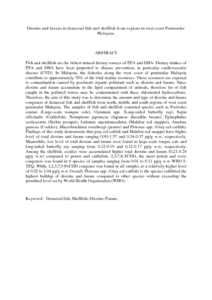Citation
Mohamad Nasir, Nurul Nadiah and Azlan, Azrina and Razman, Muhammad Rizal and Ramli, Norazam and Abdul Latiff, Aishah
(2011)
Dioxins and furans in demersal fish and shellfish from regions in west coast Peninsular Malaysia.
Journal of Food, Agriculture and Environment, 9 (2).
pp. 72-78.
ISSN 1459-0255
Abstract
Fish and shellfish are the richest natural dietary sources of EPA and DHA. Dietary intakes of EPA and DHA have been purported to disease prevention, in particular cardiovascular disease (CVD). In Malaysia, the fisheries along the west coast of peninsular Malaysia contribute to approximately 70% of the total marine resources. These resources are exposed to contamination caused by persistent organic pollutant such as dioxins and furans. Since dioxins and furans accumulate in the lipid compartment of animals, therefore fat of fish caught in the polluted waters may be contaminated with these chlorinated hydrocarbons. Therefore, the aim of this study was to determine the amount and type of dioxins and furans congeners of demersal fish and shellfish from north, middle and south regions of west coast peninsular Malaysia. The samples of fish and shellfish consisted species such as Psettodes erumei (Large-scale toungue sole), Gymnura spp. (Long-tailed butterfly ray), Sepia officinalis (Cuttlefish), Nemipterus japonicus (Japanese threadfin bream), Epinephulus sexfasciatus (Sixbar grouper), Lutianus argentimaculatus (Malabar red snapper), Anadara granosa (Cockles), Macrobrachium rosenbergi (prawn) and Plotosus spp. (Gray eel-catfish). Findings of this study demonstrate that gray eel-catfish and Malabar red snapper have higher level of total dioxins and furans ranging 0.90-1.57 and 0.34-0.37 pg/g w.w, respectively. Meanwhile, low level of total dioxins and furans were found in large-scale tongue sole and long-tailed butterfly ray ranging from 0.12-0.19 and 0.12-0.17 pg/g w.w, respectively. Among the shellfish, cockles were accumulated higher total dioxins and furans (0.21-0.24 pg/g w.w) compared to prawn and cuttlefish. 2,3,7,8-TCDD, the most potent and toxic congeners was found in 6 species of samples ranging from 0.01 to 0.11 pg/g w.w WHO I-TEQ. While 1,2,3,7,8-PeCDD congener was found in all samples at a relatively higher level of 0.02 to 1.04 pg/g w.w Overall, Plotosus spp. (Gray eel-catfish) is the species exhibited the highest buildup of dioxins and furans compared to other species without exceeding the permitted level set by World Health Organization (WHO).
Download File
![[img]](http://psasir.upm.edu.my/24659/1.hassmallThumbnailVersion/Dioxins%20and%20furans%20in%20demersal%20fish%20and%20shellfish%20from%20regions%20in%20west%20coast%20Peninsular%20Malaysia.pdf)  Preview |
|
PDF (Abstract)
Dioxins and furans in demersal fish and shellfish from regions in west coast Peninsular Malaysia.pdf
Download (85kB)
| Preview
|
|
Additional Metadata
Actions (login required)
 |
View Item |

